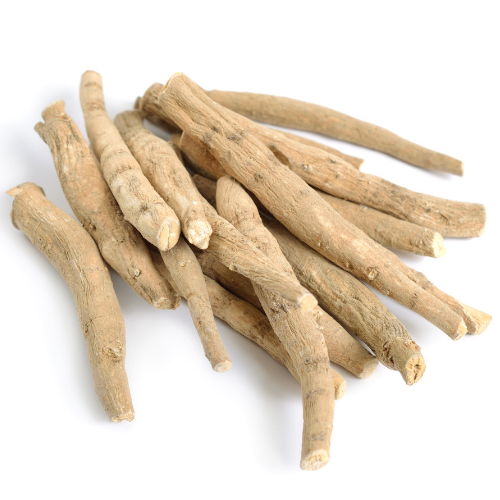
We love it for..
Anxiety, Energy, Insomnia, Fatigue
Ashwagandha has been called “Indian ginseng” because it is used in Ayurveda in much the same way that ginseng is used in Chinese medicine: to improve vitality and to aid recovery after chronic illness. It has powerful medicinal properties proven by research.
Why We Love It
Today, ashwagandha seems to be an herb designed to deal with the busy nature of modern life. It invigorates when fatigued, eases the impact of stress and anxiety, and aids sleep—all traditional uses largely supported by clinical research.
■ Ayurvedic tonic Ashwagandha has always been valued in Ayurveda for its tonic, strengthening, and relaxing properties. Robert Svoboda in Ayurveda: Life, Health, and Longevity states that it “clarifies the mind, calms and strengthens the nerves, and promotes sound restful sleep.”
■ Restorative Today, the herb is still prized as a tonic, but valued also for its unusual combination of actions. As a tonic, it strengthens and supports physical and mental performance, yet at the same time it relieves anxiety and, as its botanical name suggests, encourages better sleep quality. It is an excellent herb for convalescence.
■ Inflammatory conditions Ashwagandha can be a useful addition to treatment for chronic inflammatory diseases such as rheumatoid arthritis and psoriasis.
■ Long-term stress By reducing overactivity and encouraging rest and relaxation, ashwagandha is useful in countering the debility that accompanies long-term stress.
■ Anemia Aswagandha’s high iron content makes it useful in anemia.
How We Use It
Brands We Love
Research Resources
| Scientific Name | Withania somnifera (Solanaceae) |
| Description | A stout shrub growing to 5 ft (1.5 m), with oval leaves and greenish or yellow flowers. |
| Constituents | Alkaloids, Steroidal lactones (withanolides), Iron |
| Habitat & Cultivation | Ashwagandha is found in India, the Mediterranean, and the Middle East. It is propagated from seed or cuttings in spring. The leaves are harvested in spring, and the fruit and root in autumn. |
| Parts Used | Leaves contain the most withanolides, constituents that inhibit cancer cell growth. Root is powdered or made into decoctions and taken as a strengthening and calming tonic. Berries are chewed in India to help in convalescence. |
| Key Actions | Adaptogenic, Tonic, Mild sedative |
| Cautions | Large doses can cause upset stomach, diarrhea, and vomiting. Ashwagandha might interfere with thyroid tests. (Source: WebMD) |
Clinical Studies
■ Chronic stress Clinical research has been wide-ranging and examined many aspects of ashwagandha’s potential medicinal uses, many linked to the withanolides, compounds similar to the body’s own steroid hormones. A 2012 Indian clinical trial noted that those taking ashwagandha had lower stress levels and an increased sense of well-being, as well as lower cortisol and blood pressure levels.
■ Anxiety and tension Ashwagandha has been proven to reduce anxiety and tension in at least 6 clinical trials. In a 2009 Canadian trial, ashwagandha, paired with dietary advice and a multivitamin supplement, was found more effective in decreasing anxiety than psychotherapy and a placebo. Those taking ashwagandha also reported improved concentration and less fatigue.
■ Male fertility Two clinical trials testing ashwagandha’s role as a male sexual tonic indicate that the herb markedly improves semen quality. Another clinical trial failed to find any benefit in aiding erectile dysfunction.
■ Other actions Ashwagandha has also been researched for its use as a tonic suitable for children, to improve muscle strength and mental function in the elderly, for arthritis, and to enhance immune function. Ashwagandha is thought to have anticancer activity.
Source: Encyclopedia of Herbal Medicine